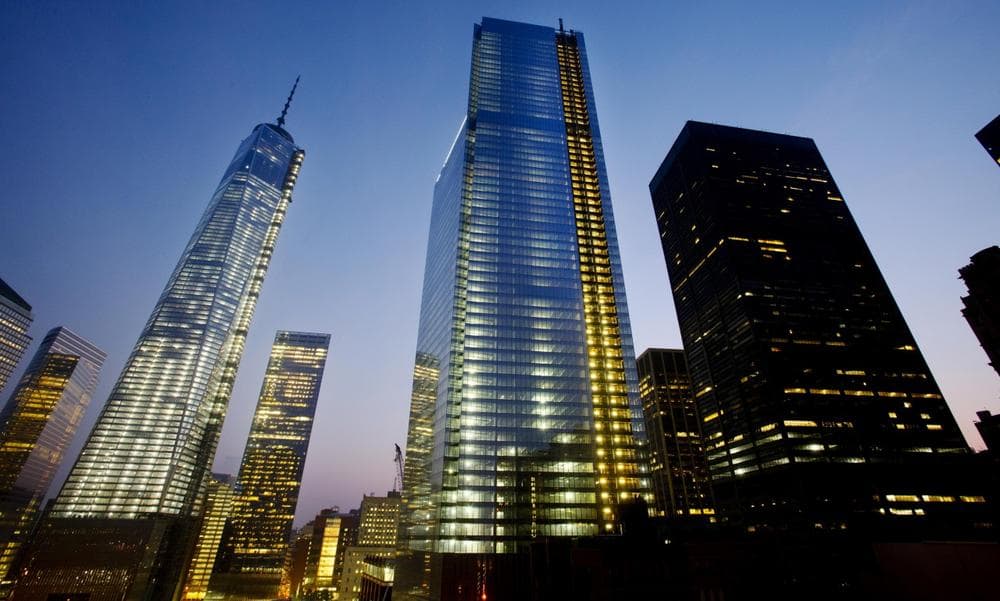Advertisement
Anthropologist Documents 'The Battle For Ground Zero'
Resume
On this, the 12th anniversary of the September 11 attacks, a new building stands on the once empty site. It's called 1 World Trade Center.
It stands a symbolic 1776 feet high. On the journey from the devastation of 2001 to the new building and memorial there today, there has been a political and emotional struggle over what the site of the attacks should represent.
In a new book, "Battle For Ground Zero: Inside the Political Struggle to Rebuild the World Trade Center," urban anthropologist Elizabeth Greenspan documents America's most fought over public space (excerpt below).
Greenspan says that as the memorial was being designed, there was tension between commerce and remembrance.
"This is one of the most valuable pieces of land in the world — it held the largest office complex in the country," she said. "But then you had all these other people who said this is a now historic piece of land where so many thousands of people were killed."
Ultimately, the memorial includes One World Trade Center, which will be used as commercial space, and a memorial area with reflecting pools and the names of those who died.
While some families are pleased with the design of the memorial plaza, other families hoped that there would be artifacts from that day incorporated into the memorial.
"For many families, they felt like there needed to be more that remembered the day itself and the attacks, and not just the twin towers," Greenspan said.
- Politico Photo Gallery: Ground zero's rebuilding through the years
- Watch Live: Anniversary ceremony on the 9/11 Memorial plaza
Book Excerpt: 'The Battle For Ground Zero'
By Elizabeth Greenspan

Preface: America the Re-build-iful
In the first months after 9/11, thousands of people descended upon the World Trade Center site in Lower Manhattan to see the destruction and, while they were there, many wrote comments on nearby walls, emergency railings, and streets signs. The graffiti was usually written in ink or marker, not spray paint, and included everything from simple signatures to original poems to increasingly political exchanges between passersby. (“Blame Bush!” “Who did the damage? Not Bush. Thank God for Bush!”) One refrain, in particular, caught my eye: “America the Re-build-iful.”
It was scrawled on a boarded-up bank entrance across from the wreckage (though after that first sighting, I spotted the refrain all over the site’s temporary architecture). It was catchier and more playful than “United We Stand” or “God Bless America,” and it seemed to capture the idealistic, unifying spirit of the times. It also expressed the idea that prompted me to pick up and head to Ground Zero in the first place: the idea that the identity of the country was inextricably tied to the rebuilding of the World Trade Center site. It was the idea that whatever we decided to build here would reveal nothing less than what makes us American. The catchy little refrain, in other words, expressed the very big stakes of the rebuilding—and presaged the bat-tles to come.

I was a 24-year-old graduate student then, in anthropology and urban studies. I was interested in the rebuilding partly because 9/11 felt so monumental, but also because I had always been intrigued by how cities worked, in particular, how people shaped and fought over space, and, after 9/11, the space everyone was talking about was Ground Zero. Once I arrived in New York, I learned that there was more than one process to examine. I went to civic group meetings and public hearings, where I met area residents, city architects, victims’ families, and rescue workers. I also went to the WTC site regularly to follow progress and conflicts on the ground, and photographed the spontane-ous memorials and graffiti, and then the construction work, the pro-tests, and the annual anniversary ceremonies. I collected reports, press releases, newspaper articles, and talked to more people. By the end of my research, I had interviewed more than 300 people at the World Trade Center site, more than 150 downtown residents, victims’ family members, rescue workers, and architects, and nearly 50 city and state officials involved in rebuilding, including the politicians, architects, and developers making key decisions.
The battles over what and how to rebuild were heated from the beginning, so much so that at times they reminded me of some of the most entrenched struggles over territory, like the Israeli-Palestinian conflict. Of course, people didn’t resort to violence to determine who owned the WTC site, a sixteen-acre parcel that is considerably smaller than, say, Jerusalem. But sixteen acres in the heart of New York City is not unlike vast, rolling tracts of property elsewhere; it certainly costs as much. And people felt very strongly about Ground Zero. Most of all, the questions that defined the battles downtown were the same ones that have triggered land conflicts everywhere. Who does it belong to? And, as importantly, how will we decide?
At the WTC site, the question of ownership appeared relatively simple: the Port Authority of New York and New Jersey owned the land, and developer Larry Silverstein owned the lease to the office space. But these were merely the legal answers, and for many people legality wasn’t the only or even the most appropriate framework to employ. Nearly three thousand people were killed at the World Trade Center, in the deadliest foreign attack on American soil in the country’s history. Was the land really owned by one individual and one institu-tion? A lot of people didn’t think so, at least not in the aftermath of the attacks. Victims’ families and neighborhood residents believed they had legitimate claims to the WTC site, as did many New Yorkers, as did many of the thousands and then millions of people coming to see the destruction. The question of ownership proved so big and open-ended it often felt rhetorical. Everyone owned Ground Zero—or, at the very least, they believed they owned a piece of it. So, they fought for their piece. For years. Some are still fighting for it.
This book tells the story of these battles. It begins in the fall of 2001, when the debates about what and how to rebuild commenced, and it ends in the fall of 2011, when the memorial opened to the pub-lic and many, though not quite all, of the major decisions had been made. It doesn’t document every conflict or participant; instead, it tells the story of the multiple forces that remade the World Trade Center site. This means that it is partly a story about owners and politicians sitting around tables in conference rooms, but it also means it is a story about people in streets, public hearings, and living rooms voicing desires, demands, concerns, and beliefs—and occasionally garnering the attention of the influential men. It is a story about capitalism and democracy. It’s a story about those who built the walls and those who wrote on them.
From BATTLE FOR GROUND ZERO by Elizabeth Greenspan. Copyright © 2013 by Elizabeth Greenspan. Reprinted by permission of Palgrave Macmillan, a division of Macmillan Publishers Ltd.
Guest
- Elizabeth Greenspan, author of "Battle For Ground Zero." She tweets @lizgreenspan.
This segment aired on September 11, 2013.